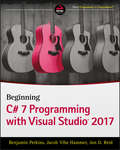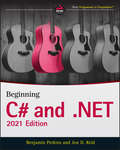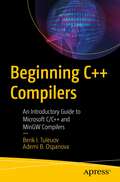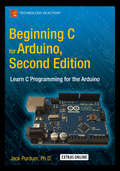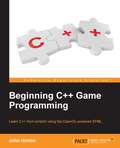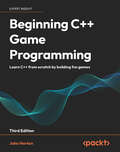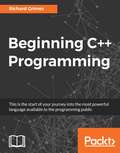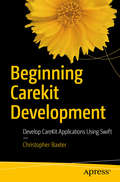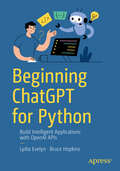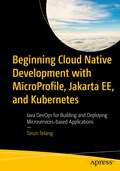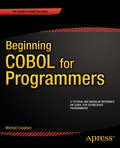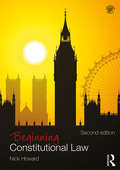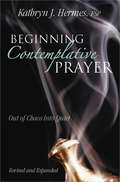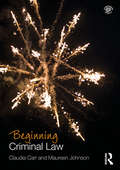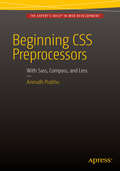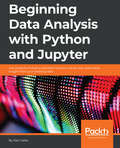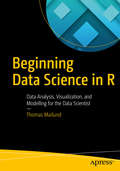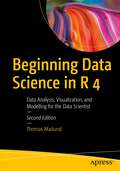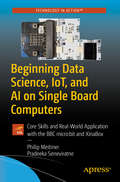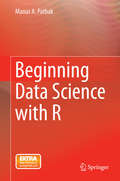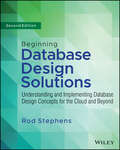- Table View
- List View
Beginning C# 7 Programming with Visual Studio 2017
by Benjamin Perkins Jacob Vibe Hammer Jon D. ReidEasily get started programming using the ultra-versatile C# 7 and Visual Studio 2017 Beginning C# 7 Programming with Visual Studio 2017 is the beginner’s ultimate guide to the world’s most popular programming language. Whether you’re new to programming entirely, or just new to C#, there has never been a better time to get started. The new C# 7 and Visual Studio 2017 updates feature a number of new tools and features that streamline the workflow, simplify the code, and make it easier than ever to build high-quality apps. This book walks you through everything you need to know, starting from the very basics, to have you programming in no time. You’ll learn about variables, flow control, and object oriented programming, then move into Web and Windows programming as well as databases and XML. The companion website provides downloadable code examples, and practical Try It Out sections provide explicit, step-by-step instructions for writing your own useful, customizable code. C# 7 can be used to build Windows applications, program Windows 10, and write Web apps when used alongside ASP.NET. With programming skills becoming de rigueur in fields far beyond the tech world, C# 7 is a great place to start building versatile, helpful skills. This book gets you started quickly and easily with instruction from a master-team of C# programmers. Learn how to program using the world’s leading programming language Build smarter, faster apps using the latest features in C# 7 and Visual Studio 2017 Find and fix bugs sooner, saving headaches down the line Integrate with all .NET Core, Azure applications, cloud services, Docker containers, and more The world of programming can seem intimidating to a beginner, and the prospect of learning a whole new “language” can seem daunting. Beginning C# 7 Programming with Visual Studio 2017 demystifies the process and shows you how to bring your ideas to life.
Beginning C# and .NET
by Benjamin Perkins Jon D. ReidGet a running start to learning C# programming with this fun and easy-to-read guide As one of the most versatile and powerful programming languages around, you might think C# would be an intimidating language to learn. It doesn’t have to be! In Beginning C# and .NET: 2021 Edition, expert Microsoft programmer and engineer Benjamin Perkins and program manager Jon D. Reid walk you through the precise, step-by-step directions you’ll need to follow to become fluent in the C# language and .NET. Using the proven WROX method, you’ll discover how to understand and write simple expressions and functions, debug programs, work with classes and class members, work with Windows forms, program for the web, and access data. You’ll even learn about some of the new features included in the latest releases of C# and .NET, including data consumption, code simplification, and performance. The book also offers: Detailed discussions of programming basics, like variables, flow control, and object-oriented programming that assume no previous programming experience “Try it Out” sections to help you write useful programming code using the steps you’ve learned in the book Downloadable code examples from wrox.com Perfect for beginning-level programmers who are completely new to C#, Beginning C# and .NET: 2021 Edition is a must-have resource for anyone interested in learning programming and looking for a fun and intuitive place to start.
Beginning C++ Compilers: An Introductory Guide to Microsoft C/C++ and MinGW Compilers
by Berik I. Tuleuov Ademi B. OspanovaThis book focuses on how to install C/C++ compilers on Linux and Windows platforms in a timely and efficient way. Installing C/C++ compilers, especially Microsoft compilers, typically takes quite a lot of time because it comes with Microsoft Visual Studio for the vast majority of users. Installing Visual Studio requires usually about 40 GB of disk space and a large amount of RAM, so it is impossible to use weak hardware. The authors provide an easy way to deploy Microsoft C/C++ compiler: with no disk space headache and hardware resources lack. The method described saves significant time since software can even be deployed on removable devices, such as flash sticks, in an easy and portable way. It is achieved by using Enterprise Windows Driver Kit (EWDK), single big ISO image, which can be mounted as virtual device and used directly without any installation. EWDK contains everything from Visual Studio except IDE. EWDK also allows to use MASM64 (Microsoft Macro-Assembly) and C# compilers. With the aid of the MSBuild System, one can compile Visual Studio Projects (.vcxproj) and Solutions (.sln) without even using Visual Studio! Similarly, MinGW compilers can be deployed from 7z/zip archives, simply by unpacking into appropriate location. Both Microsoft C/C++ and MinGW compilers can be used as portable software—an approach that does not require administrative privileges at all. What you’ll learn Rapid installation of modern Microsoft C/C++ and MinGW compilers.How to prepare reusable and portable Microsoft C/C++ and MinGW compilers suite on removable media (flash stick, CD/DVD).How to use Microsoft C/C++ and MinGW compilers even on old/slow computers without standard installation.How to build under Windows the libraries originally designed for Unix-systems.Learn to run multiple versions of these compilers at the same time. Who This Book Is For Reader of all skills who wants to save time and efforts to start to work with C++. Also useful for scientists who are not familiar with software installation.
Beginning C for Arduino: Learn C Programming for the Arduino
by Jack PurdumBeginning C for Arduino, Second Edition is written for those who have no prior experience with microcontrollers or programming but would like to experiment and learn both. Updated with new projects and new boards, this book introduces you to the C programming language, reinforcing each programming structure with a simple demonstration of how you can use C to control the Arduino family of microcontrollers. Author Jack Purdum uses an engaging style to teach good programming techniques using examples that have been honed during his 25 years of university teaching. Beginning C for Arduino, Second Edition will teach you: The C programming language How to use C to control a microcontroller and related hardware How to extend C by creating your own libraries, including an introduction to object-oriented programming During the course of the book, you will learn the basics of programming, such as working with data types, making decisions, and writing control loops. You'll then progress onto some of the trickier aspects of C programming, such as using pointers effectively, working with the C preprocessor, and tackling file I/O. Each chapter ends with a series of exercises and review questions to test your knowledge and reinforce what you have learned. What you'll learn The syntax of the C programming language as defined for the Arduino Tried and true coding practices (applicable to any programming language) How to design, code, and debug programs that drive Arduino microcontrollers How to extend the functionality of C How to integrate low cost, off-the-shelf, hardware shields into your own projects Who this book is for The book is aimed at a complete novice with no programming background. It assumes no prior programming or hardware design experience and is written for creative and curious people who would like to blend a software and hardware learning experience into a single, enjoyable endeavor. Table of Contents Introduction to Arduino Microcontrollers Arduino C Data Types Decision Making in C Program Loops Functions in C Storage Classes and Scope Introduction to Pointers Using Pointers Effectively I/O Operations The C Preprocessor A Gentle Introduction to Object-Oriented Programming Arduino Libraries Arduino I/O Appendix A - Suppliers Appendix B - Hardware Components
Beginning C++ Game Programming
by John HortonLearn C++ from scratch using the OpenGL-powered SFMLAbout This BookThis book offers a fun way to learn modern C++ programming while building exciting 2D gamesThis beginner-friendly guide offers a fast-paced but engaging approach to game developmentDive headfirst into building a wide variety of desktop games that gradually increase in complexityIt is packed with many suggestions to expand your finished games that will make you think critically, technically, and creativelyWho This Book Is ForThis book is for those who have no C++ programming knowledge whatsoever and want to learn to build games or just use games as a more engaging way to learn C++. If you have aspirations of one day publishing a game on Steam or just want to have a load of fun while learning C++, then this book was written for you.What You Will LearnGet to know C++ from scratch while simultaneously learning about building gamesMake C++ game coding appear like it is something that any determined person can doGet a competent level knowledge of C++ programming.Build exciting games with a wide range of featuresGet ready to go and build your own unique gamesIn DetailThis book is all about offering you a fun introduction to the world of game programming and C++. It will begin by teaching you the programming basics such as variables, loops, and conditions using game-like mini apps.We then move on to build actual working games. Throughout the course of the book, you will learn to build three different styles of games comprising a frantic two-button-tapper, a zombie survival/shooter, and a multiplayer platformer. While building these games, you will learn some more C++ programming concepts such as OOP and data storage/complexity. We'll end by creating a multiplayer shooter game and will also introduce you to some of the advanced capabilities of C++ such as networking and advanced OOP.As the games gradually increase in complexity, you will explore some of the advanced capabilities of C++ as well as some exciting new game programming techniques.
Beginning C++ Game Programming: Learn C++ from scratch by building fun games
by null John HortonGet to grips with programming and game development techniques using C++ libraries and Visual Studio 2022 with this updated edition of the bestselling series.Key FeaturesCreate fun games in C++, with this up-to-date guide covering the latest features of C++20 and VS2022Build clones of popular games such as a Timberman clone, a Pong game, a Zombie Survival Shooter, and a platform endless runner gameDiscover tips to expand your finished games by thinking critically, technically, and creativelyBook DescriptionAlways dreamed of creating your own games? With the third edition of Beginning C++ Game Programming, you can turn that dream into reality! This beginner-friendly guide is updated and improved to include the latest features of VS 2022, SFML, and modern C++20 programming techniques. You'll get a fun introduction to game programming by building four fully playable games of increasing complexity. You'll build clones of popular games such as Timberman, Pong, a Zombie survival shooter, and an endless runner. The book starts by covering the basics of programming. You'll study key C++ topics, such as object-oriented programming (OOP) and C++ pointers and get acquainted with the Standard Template Library (STL). The book helps you learn about collision detection techniques and game physics by building a Pong game. As you build games, you'll also learn exciting game programming concepts such as vertex arrays, directional sound (spatialization), OpenGL programmable shaders, spawning objects, and much more. You’ll dive deep into game mechanics and implement input handling, levelling up a character, and simple enemy AI. Finally, you'll explore game design patterns to enhance your C++ game programming skills. By the end of the book, you'll have gained the knowledge you need to build your own games with exciting features from scratch.What you will learnSet up your game project in VS 2022 and explore C++ libraries such as SFMLBuild games in C++ from the ground up, including graphics, physics, and input handlingImplement core game concepts such as game animation, game physics, collision detection, scorekeeping, and game soundImplement automatically spawning objects and AI to create rich and engaging experiencesLearn advanced game development concepts, such as OpenGL shaders, texture atlases, and parallax backgroundsScale and reuse your game code with modern game programming design patternsWho this book is forThis book is perfect for you if you have no C++ programming knowledge, you need a beginner-level refresher course, or you want to learn how to build games or just use games as an engaging way to learn C++. Whether you aspire to publish a game (perhaps on Steam) or just want to impress friends with your creations, you'll find this book useful
Beginning C# Hands-On - The Core Language
by Tom OwsiakA C# beginners guide to the core parts of the C# language! About This Book • Learn C#, Visual Studio, and Object Oriented Programming • See practical examples of all the core C# language features so that you can easily master them yourself • Use the C# programming language to work with code and data, which can be applied to other programming languages as well • Complete a variety of programming assignments for hands-on practice, as you move through the course Who This Book Is For This book will appeal to anyone who is interested in learning how to program in C#. Previous programming experience will help you get through the initial sections with ease, although, it's not mandatory to possess any experience at all. What You Will Learn • Learn C#, Visual Studio, and object-oriented programming • Learn all the core C# language syntax with hands-on working examples • Learn everything from basic variable assignments to complex multidimensional arrays • Go through practical examples of all the core C# language features so that you can easily master them yourself • Use the C# programming language to work with code and data, which can be applied to other programming languages as well In Detail Beginning C# Hands-On - The Core Language teaches you core C# language and syntax in a working Visual Studio environment. This book covers everything from core language through to more advanced features such as object-oriented programming techniques. This book is for C# beginners who need a practical reference to core C# language features. You'll also gain a view of C# through web programming with web forms, so you'll learn HTML, basic CSS, and how to use a variety of controls, such as buttons and drop-down lists. You'll start with the fundamentals of C# and Visual Studio, including defining variables, interacting with users, and understanding data types, data conversions, and constants. You'll move on to checking conditions using if/else blocks, and see how to use loops to do things such as repeat blocks of code. After covering various operators to evaluate and assign control structures, you'll see how to use arrays to store collections of data. By the time you've finished the book, you'll know how to program the vital elements of the core C# language. These are the building blocks that you can then combine to build complex C# programs. Style and approach A comprehensive book that blends theory with just the right amount of practical code implementations, to help you get up and running with the C# programming language. You'll also get to work with other tools and technologies that complement C# programming. Each core part of the C# language is coded as you learn, and code output is tested every time to verify the syntax is working as expected, so it's easy for you to learn directly from the working code examples.
Beginning C++ Programming
by Richard GrimesModern C++ at your fingertips! About This Book • This book gets you started with the exciting world of C++ programming • It will enable you to write C++ code that uses the standard library, has a level of object orientation, and uses memory in a safe and effective way • It forms the basis of programming and covers concepts such as data structures and the core programming language Who This Book Is For A computer, an internet connection, and the desire to learn how to code in C++ is all you need to get started with this book. What You Will Learn • Get familiar with the structure of C++ projects • Identify the main structures in the language: functions and classes • Feel confident about being able to identify the execution flow through the code • Be aware of the facilities of the standard library • Gain insights into the basic concepts of object orientation • Know how to debug your programs • Get acquainted with the standard C++ library In Detail C++ has come a long way and is now adopted in several contexts. Its key strengths are its software infrastructure and resource-constrained applications, including desktop applications, servers, and performance-critical applications, not to forget its importance in game programming. Despite its strengths in these areas, beginners usually tend to shy away from learning the language because of its steep learning curve. The main mission of this book is to make you familiar and comfortable with C++. You will finish the book not only being able to write your own code, but more importantly, you will be able to read other projects. It is only by being able to read others' code that you will progress from a beginner to an advanced programmer. This book is the first step in that progression. The first task is to familiarize you with the structure of C++ projects so you will know how to start reading a project. Next, you will be able to identify the main structures in the language, functions, and classes, and feel confident being able to identify the execution flow through the code. You will then become aware of the facilities of the standard library and be able to determine whether you need to write a routine yourself, or use an existing routine in the standard library. Throughout the book, there is a big emphasis on memory and pointers. You will understand memory usage, allocation, and access, and be able to write code that does not leak memory. Finally, you will learn about C++ classes and get an introduction to object orientation and polymorphism. Style and approach This straightforward tutorial will help you build strong skills in C++ programming, be it for enterprise software or for low-latency applications such as games or embedded programming. Filled with examples, this book will take you gradually up the steep learning curve of C++.
Beginning CareKit Development: Develop CareKit Applications Using Swift
by Christopher BaxterThis book offers readers a fantastic introduction into creating CareKit based applications using the Swift language. It starts with the basics and provides a step-by-step guide to learning all aspects of creating a CareKit iOS application that could serve as the basis for a patient care plan. Beginning Carekit Development introduces the key modules and concepts of CareKit starting off by installing and building the open source framework. Developers will then dive deeper, learning how to implement their own care plan by example. The book will present an illness and complete care plan utilizing all the key modules. Readers will then be able to fully use CareKit to develop health care plans. This is the future of patient care and health tracking apps that put patients in control of their day to day care. Throughout the book, app developers, hardware manufacturers, and health care professionals will get tips and suggestions that show how to use and talk about this exciting new technology. The CareKit framework has the simple interface and the secure functionality that will change existing markets. Beginning Carekit Development is the guide to the new world of CareKit. What you'll learn: The basics of CareKit development from creating a simple "Hello World" app up to full fledged care plan application. How to integrate CareKit with HealthKit, ResearchKit, and other Apple devices to create an ecosystem of connected health care devices. How to assess and share treatment insights with caregivers and key contacts through CareKit with access to key health information. Who this book is for: Developers working in healthcare and medical device fields will use this book to develop medical apps meant to integrate directly with the ubiquitous Apple devices everyone has.
Beginning ChatGPT for Python: Build Intelligent Applications with OpenAI APIs
by Lydia Evelyn Bruce HopkinsUnlock the future of software development and empower yourself to elevate your Python applications by harnessing the power of AI as this field continues to grow and evolve. Perfect for beginner to intermediate Python programmers, this book breaks down the essentials of using ChatGPT and OpenAI APIs. You'll start with the basics, learning to authenticate, send prompts, generate responses, test in the Playground, and handle errors with ease. Each chapter includes hands-on exercises that bring concepts to life, demonstrating different API functionalities and practical applications. You'll master models like GPT-4o, GPT-4, GPT-3.5, Whisper, and DALL-E, enabling you to enhance your applications with cutting-edge AI. Discover how generative AI tools like ChatGPT can automate tedious tasks rather than replace jobs. Leverage ChatGPT’s powerful Natural Language Processing (NLP) capabilities to handle various formats of unstructured text within your Python apps. Quickly see how easy it is to use ChatGPT as your AI-pair programmer, boosting your productivity and speed. This step-by-step guide will have you creating intelligent chatbots that can automatically process messages from Slack or Discord. With Beginning ChatGPT for Python, you'll master the ChatGPT and OpenAI APIs, building intelligent applications that offer a personalized and engaging user experience. What You’ll Learn Connect with the ChatGPT and OpenAI APIs and send effective prompts. Harness parameters like temperature and top_p to create unique and engaging responses from ChatGPT. Create an intelligent assistant bot for Slack that automates tasks and enhances productivity. Develop a bot that can moderate conversations and manage communities on Discord. Add context to your prompts to get more accurate and relevant responses. Who This Book Is For Python developers and enthusiasts who aspire to employ OpenAI and ChatGPT in the creation of intelligent applications to enhance productivity.
Beginning Clerical Worker: Passbooks Study Guide (Career Examination Series)
by National Learning CorporationThe Beginning Clerical Worker Passbook® prepares you for your test by allowing you to take practice exams in the subjects you need to study. It provides hundreds of questions and answers in the areas that will likely be covered on your upcoming exam, including but not limited to: Name and Number Checking; Coding Information; Clerical Operations with Letters and Numbers; Filing; Arithmetic Computations; Arithmetic Reasoning; and more.
Beginning Cloud Native Development with MicroProfile, Jakarta EE, and Kubernetes: Java DevOps for Building and Deploying Microservices-based Applications
by Tarun TelangGet ready to develop microservices using open source Eclipse MicroProfile and Jakarta EE, and deploy them on Kubernetes/Docker. This book covers best practices for developing cloud-native applications with MicroProfile and Jakarta EE.This book introduces you to cloud-native applications and teaches you how to set up your development environment. You'll learn about the various components of MicroProfile, such as fault tolerance, config, health check, metrics, and JWT auth. You'll develop a RESTful web service made up of some microservices. You'll deploy your application on Docker and Kubernetes.After reading this book, you'll come away with the fundamentals you need to build and deploy your first cloud-native Java-based app.What You'll LearnBuild your first cloud-native Java-based app with the open source MicroProfile platform, and Jakarta EE 10 APIs Develop a RESTful web service using MicroProfile and Jakarta EEDiscover and explore the key components of the MicroProfile framework, such as config, metrics, health, JWT authentication, and moreDeploy your cloud-native application on the Kubernetes container orchestration platformGet up to speed with other popular technologies such as Docker containers, Kubernetes clusters, and ZipkinWho This Book Is ForProgrammers with at least some prior experience in Java programming who may be new to MicroProfile and Jakarta EE. Some prior experience with Java-based microservices and web development is recommended, but not required.
Beginning COBOL for Programmers
by Michael CoughlanBeginning COBOL for Programmersais a comprehensive, asophisticated tutorial and modular skills referenceaon the COBOL programming language for established programmers. This book is for you if you are a developer who would like to - or must - add COBOL to your repertoire. Perhaps you recognize the opportunities presented by the current COBOL skills crisis, or you may be working in a mission critical enterprise which retains legacy COBOL applications. Whatever your situation, aBeginning COBOL for Programmers meets your needs as an established programmer moving to COBOL. Beginning COBOL for Programmersaincludes coverage of the latest COBOL featuresaand techniques, including control structures, tabular data, sequential files, procedure divisions, string handling, decimal arithmetic, report writer, object-orientedaCOBOL, and more. aYou'll receive extensive introductions to the core features of the COBOL language, and then find solutions about how to effectively deploy COBOL to build robust mission critical enterprise applications that talk to legacy enterprise applications or aspects of those applications. If you've inherited some legacy COBOL, you'll be able to grasp the COBOL idioms and recognize what's happening in the code you're working with. The death of COBOL has been predicted time and time again, yet COBOL still remains a dominant force at the heart of enterprise computing. aIn 1997, the Gartner group estimated that of the 300 billion lines of code in the world, 240 billion (80%) were written in COBOL, and that dominance is not greatly changed today. aBut there is a crisis on the horizon. aWhile the number of COBOL programmers reaching retirement age has created a growing shortage, attempts to rewrite COBOL legacy systems in a more fashionable language have oftenanot been successful or put aside for a number of reasons. Therefore, today's enterprise application developers - mostly skilled at C++, C# and Java - can find COBOL skills open new - or old - doors, and this handy reliable reference is a book that you can turn to for your COBOL skills. "
Beginning Constitutional Law (Beginning the Law)
by Nick HowardWhether you’re new to higher education, coming to legal study for the first time or just wondering what Constitutional Law is all about, Beginning Constitutional Law is the ideal introduction to help you hit the ground running. Adopting a clear and simple approach with legal vocabulary explained in a detailed glossary avaliable on the companion website, Nick Howard breaks the subject of constitutional law down using practical everyday examples to make it understandable for anyone, whatever their background. Diagrams and flowcharts simplify complex issues, important cases are identified and explained, and on-the- spot questions help you recognise potential issues or debates within the law so that you can contribute in classes with confidence. This second edition has been updated to keep up to date with developments both before and after the 2015 General Election as well as ongoing proposals for reform, including: • The referendum on independence for Scotland, increased devolved powers and the continued threat of the break-up of the Union. • Proposals to repeal the Human Rights Act 1998 and replace it with a British Bill of Rights. • The in/out referendum on EU membership. • Reform of the role and composition of the House of Lords. Beginning Constitutional Law is an ideal first introduction to the subject for LLB, GDL or ILEX and especially international students, those enrolled on distance learning courses or on other degree programmes.
Beginning Contemplative Prayer
by Kathryn J. HermesIn this practical guide, best-selling author Kathryn J. Hermes, FSP, demonstrates how to begin a life of contemplative prayer. You don't have to be a mystic to learn this type of prayer, just a person who is seeking a deeper communion with God. Sr. Kathryn has helped thousands of people through difficult times. Now let her guide you in this timeless form of meditative prayer.
Beginning Contract Law (Beginning the Law)
by Nicola Monaghan Chris MonaghanWhether you’re new to higher education, coming to legal study for the first time or just wondering what Contract Law is all about, Beginning Contract Law is the ideal introduction to help you hit the ground running. Starting with the basics and an overview of each topic, it will help you come to terms with the structure, themes and issues of the subject so that you can begin your Contract Law module with confidence. Adopting a clear and simple approach with legal vocabulary explained in a detailed glossary, Chris and Nicola Monaghan break the subject of Contract law down using practical everyday examples to make it understandable for anyone, whatever their background. Diagrams and flowcharts simplify complex issues, important cases are identified and explained and on-the- spot questions help you recognise potential issues or debates within the law so that you can contribute in classes with confidence. Beginning Contract Law is an ideal first introduction to the subject for LLB, GDL or ILEX and especially international students, those enrolled on distance learning courses or on other degree programmes.
Beginning Criminal Law (Beginning the Law)
by Maureen Johnson Claudia CarrWhether you’re new to higher education, coming to legal study for the first time or just wondering what Criminal Law is all about, Beginning Criminal Law is the ideal introduction to help you hit the ground running. Starting with the basics and an overview of each topic, it will help you come to terms with the structure, themes and issues of the subject so that you can begin your Criminal Law module with confidence. Adopting a clear and simple approach with legal vocabulary explained in a detailed glossary, Claudia Carr and Maureen Johnson break the subject of criminal law down using practical everyday examples to make it understandable for anyone, whatever their background. Diagrams and flowcharts simplify complex issues, important cases are identified and explained and on-the- spot questions help you recognise potential issues or debates within the law so that you can contribute in classes with confidence. Beginning Criminal Law is an ideal first introduction to the subject for LLB, GDL or ILEX and especially international students, those enrolled on distance learning courses or on other degree programmes.
Beginning CSS
by Richard York Ian PounceyCompletely updated material and new examples show you what CSS can doWith the latest versions of Firefox, Safari, Internet Explorer, and other browsers released, CSS is more essential than ever. This beginner guide demonstrates how cascading style sheets can be used to define styles to items in Web pages, rather than format each item individually. Each lesson in this full-color book has been methodically revised to be more concise and efficient, making your learning experience as productive as possible.Covers the latest in CSS, including the new features of Internet Explorer, Firefox, Safari, and Google ChromeReviews the vast improvements to mobile browsers and how CSS can work with themProvides helpful examples and walks you through real-world solutions to common hurdlesDiscusses embedded fonts, compatibility tables, and cross-browser bug scenariosBeginning CSS, Third Edition gets you completely up to date so that you can start using CSS in the newest Web and mobile browsers today!
Beginning CSS Preprocessors: With SASS, Compass.js and Less.js
by Anirudh PrabhuLearn how preprocessors can make CSS scalable and easy to maintain. You'll see how to write code in a very clean and scalable manner and use CSS preprocessor features such as variables and looping, which are missing in CSS natively. Reading Beginning CSS Preprocessors will make your life much simpler by showing you how to create reusable chunks of code. In addition to coding enhancements, you'll also learn to automate processes such as generating image sprites and minifying code. Beginning CSS Preprocessors is your guide for getting started with CSS preprocessors. This book shows you how to use CSS in your day-to-day work and thus be smart and efficient at writing CSS. What you'll learn What are preprocessors What are the known preprocessor frameworks What are the features of Sass (Syntactically Awesome Stylesheets) What is Compass (COMPrehensive ASSembler) What is Less (Leaner SS) Who this book is for UI developers who are well acquainted with CSS and want to make their workflow better. Table of Contents Chapter 1: Introduction to Preprocessors Chapter 2: Introduction to SASS Chapter 3: Advanced SASS Chapter 4: Development with Less Chapter 5: Introduction to Compass
Beginning Data Analysis with Python And Jupyter [Book]: Use powerful industry-standard tools to unlock new, actionable insight from your existing data
by Alex GaleaUse powerful industry-standard tools to unlock new, actionable insight from your existing dataKey Features Get up and running with the Jupyter ecosystem and some example datasets Learn about key machine learning concepts like SVM, KNN classifiers and Random Forests Discover how you can use web scraping to gather and parse your own bespoke datasets Book DescriptionGetting started with data science doesn’t have to be an uphill battle. This step-by-step guide is ideal for beginners who know a little Python and are looking for a quick, fast-paced introduction. Get to grips with the skills you need for entry-level data science in this hands-on Python and Jupyter course. You’ll learn about some of the most commonly used libraries that are part of the Anaconda distribution, and then explore machine learning models with real datasets to give you the skills and exposure you need for the real world.We'll start with understanding the basics of Jupyter and its standard features. You'll be analyzing an example of a data analytics report. After analyzing a data analytics report, next step is to implement multiple classification algorithms. We’ll then show you how easy it can be to scrape and gather your own data from the open web, so that you can apply your new skills in an actionable context. Finish up by learning to visualize these data interactively.What you will learn Identify potential areas of investigation and perform exploratory data analysis Plan a machine learning classification strategy and train classification models Use validation curves and dimensionality reduction to tune and enhance your models Scrape tabular data from web pages and transform it into Pandas DataFrames Create interactive, web-friendly visualizations to clearly communicate your findings Who this book is forThis course is ideal for professionals with a variety of job descriptions across large range of industries, given the rising popularity and accessibility of data science. You'll need some prior experience with Python, with any prior work with libraries like Pandas, Matplotlib and Pandas providing you a useful head start.
Beginning Data Science in R
by Thomas MailundDiscover best practices for data analysis and software development in R and start on the path to becoming a fully-fledged data scientist. This book teaches you techniques for both data manipulation and visualization and shows you the best way for developing new software packages for R.Beginning Data Science in R details how data science is a combination of statistics, computational science, and machine learning. You’ll see how to efficiently structure and mine data to extract useful patterns and build mathematical models. This requires computational methods and programming, and R is an ideal programming language for this. This book is based on a number of lecture notes for classes the author has taught on data science and statistical programming using the R programming language. Modern data analysis requires computational skills and usually a minimum of programming. What You Will LearnPerform data science and analytics using statistics and the R programming languageVisualize and explore data, including working with large data sets found in big dataBuild an R packageTest and check your codePractice version controlProfile and optimize your codeWho This Book Is ForThose with some data science or analytics background, but not necessarily experience with the R programming language.
Beginning Data Science in R 4: Data Analysis, Visualization, and Modelling for the Data Scientist
by Thomas MailundDiscover best practices for data analysis and software development in R and start on the path to becoming a fully-fledged data scientist. Updated for the R 4.0 release, this book teaches you techniques for both data manipulation and visualization and shows you the best way for developing new software packages for R. Beginning Data Science in R 4, Second Edition details how data science is a combination of statistics, computational science, and machine learning. You’ll see how to efficiently structure and mine data to extract useful patterns and build mathematical models. This requires computational methods and programming, and R is an ideal programming language for this. Modern data analysis requires computational skills and usually a minimum of programming. After reading and using this book, you'll have what you need to get started with R programming with data science applications. Source code will be available to support your next projects as well.Source code is available at github.com/Apress/beg-data-science-r4.What You Will LearnPerform data science and analytics using statistics and the R programming languageVisualize and explore data, including working with large data sets found in big dataBuild an R packageTest and check your codePractice version controlProfile and optimize your codeWho This Book Is ForThose with some data science or analytics background, but not necessarily experience with the R programming language.
Beginning Data Science, IoT, and AI on Single Board Computers: Core Skills and Real-World Application with the BBC micro:bit and XinaBox
by Philip Meitiner Pradeeka SeneviratneLearn to use technology to undertake data science and to leverage the Internet of Things (IoT) in your experimentation. Designed to take you on a fascinating journey, this book introduces the core concepts of modern data science. You'll start with simple applications that you can undertake on a BBC micro:bit and move to more complex experiments with additional hardware. The skills and narrative are as generic as possible and can be implemented with a range of hardware options. One of the most exciting and fastest growing topics in education is data science. Understanding how data works, and how to work with data, is a key life skill in the 21st century. In a world driven by information it is essential that students are equipped with the tools they need to make sense of it all. For instance, consider how data science was the key factor that identified the dangers of climate change -- and continues to help us identify and react to the threats it presents. This book explores the power of data and how you can apply it using hardware you have at hand. You'll learn the core concepts of data science, how to apply them in the real world and how to utilize the vast potential of IoT. By the end, you'll be able to execute sophisticated and meaningful data science experiments - why not become a citizen scientist and make a real contribution to the fight against climate change. There is something of a digital revolution going these days, especially in the classroom. With increasing access to microprocessors, classrooms are are incorporating them more and more into lessons. Close to 5 million BBC micro:bits will be in the hands of young learners by the end of the year and millions of other devices are also being used by educators to teach a range of topics and subjects. This presents an opportunity: microprocessors such as micro:bit provide the perfect tool to use to build 21st century data science skills. Beginning Data Science and IoT on the BBC micro:bit provides you with a solid foundation in applied data science.What You'll Learn · Use sensors with a microprocessor to gather or "create" data · Extract, tabulate, and utilize data it from the microprocessor · Connect a microprocessor to an IoT platform to share and then use the data we collect · Analyze and convert data into information Who This Book Is For Educators, citizen scientists, and tinkerers interested in an introduction to the concepts of IoT and data on a broad scale.
Beginning Data Science with R
by Manas A. Pathak"We live in the age of data. In the last few years, the methodology of extracting insights from data or "data science" has emerged as a discipline in its own right. The R programming language has become one-stop solution for all types of data analysis. The growing popularity of R is due its statistical roots and a vast open source package library. The goal of "Beginning Data Science with R" is to introduce the readers to some of the useful data science techniques and their implementation with the R programming language. The book attempts to strike a balance between the how: specific processes and methodologies, and understanding the why: going over the intuition behind how a particular technique works, so that the reader can apply it to the problem at hand. This book will be useful for readers who are not familiar with statistics and the R programming language.
Beginning Database Design Solutions: Understanding and Implementing Database Design Concepts for the Cloud and Beyond
by Rod StephensA concise introduction to database design concepts, methods, and techniques in and out of the cloud In the newly revised second edition of Beginning Database Design Solutions: Understanding and Implementing Database Design Concepts for the Cloud and Beyond, Second Edition, award-winning programming instructor and mathematician Rod Stephens delivers an easy-to-understand guide to designing and implementing databases both in and out of the cloud. Without assuming any prior database design knowledge, the author walks you through the steps you’ll need to take to understand, analyze, design, and build databases. In the book, you’ll find clear coverage of foundational database concepts along with hands-on examples that help you practice important techniques so you can apply them to your own database designs, as well as: Downloadable source code that illustrates the concepts discussed in the book Best practices for reliable, platform-agnostic database design Strategies for digital transformation driven by universally accessible database design An essential resource for database administrators, data management specialists, and database developers seeking expertise in relational, NoSQL, and hybrid database design both in and out of the cloud, Beginning Database Design Solutions is a hands-on guide ideal for students and practicing professionals alike.
